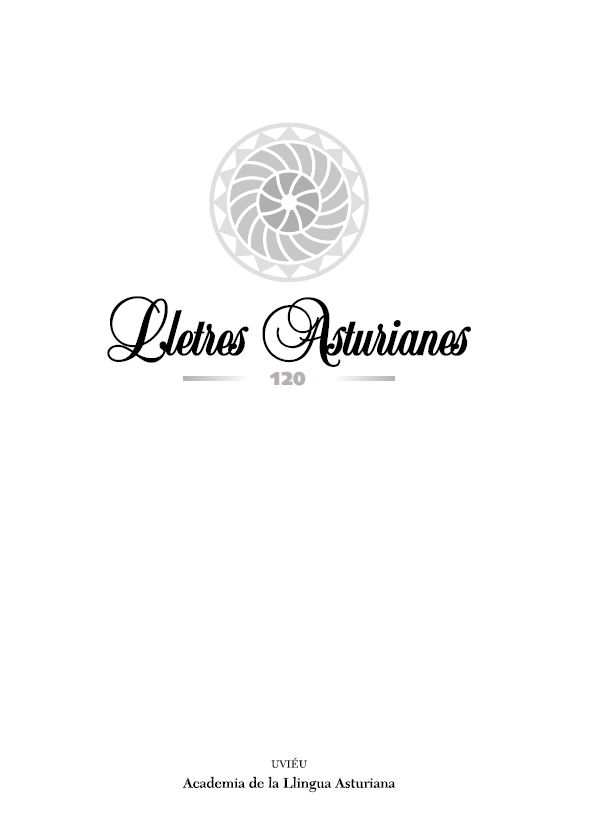Abstract
This paper puts forward an imagological analysis of Asturian fiction cinema. Traditionally, imagology has been used in comparative literature as a means
of analysis of specific traits of national literatures, such as themes, characters, archetypes and the perceptions abroad. More recently, imagology has adopted sociological and semiotic perspectives to develop more sophisticated analytical tools in the study not only of literature but also of those cinematic and artistic discourses that have become characteristic of contemporary complex, post-identity societies. The paper focuses on two of these imagological concepts and their possible application to the contemporary cinema made in Asturias. Firstly, the asymmetry between Asturian self-image and hetero-image in fiction films shot in Asturias – the former revealing an Asturian perspective while the latter is commonly associated to non-Asturian views of the region. Secondly, the notion of place branding and the diverse ways it is mobilized in relation to Asturias in contemporary cinema. A detailed study of Brand Asturias would require a much broader analysis and would go beyond the cinematic scope of this paper; however, it is put forward that fiction cinema contains important clues that can shed light in the rhetoric and politics of Brand Asturias as films aptly condense the Brand’s main proposition and project them both to the rest of the county and internationally. Some of the most salient propositions are described in this paper, including the use of the Asturian language, literary and cinematic intertextuality, references to the history and politics and Asturias, and the popular appeal of branding campaigns such as «Asturias, Paraíso Natural / Asturias, Nature’s Paradise».
References
ARMÁN, Adolfo y Jacinto MELCÓN (1956): Asturias con su costa verde, paraíso ideal del turista. Oviedo, Grossi.
BANDE, Ramón Lluís (2016): Cuaderno del paisaje: materiales para un ensayo cinematográfico sobre la guerrilla republicana asturiana. Santander, Asociación Shangrila Textos Aparte.
BARREIRO MACEIRAS, Damián (2014): «La nación televisada: llingua y identidá nos programes
n’asturianu de la Televisión del Principáu d’Asturies (TPA)», en Lletres Asturianes 111: 219-
BELLER, Manfred y Joep LEERSSEN (2007): Imagology: The Cultural Construction and Literary
Representation of National Characters. Amsterdam/New York, Rodopi.
BELLO, Xuan (1999): La vida perdida. Xixón, Llibros del Pexe.
CABEZAS, Juan Antonio (1956): Asturias: Biografía de una Región. Madrid, Espasa-Calpe. [2ª
edición, 1970].
CAMPAL FERNÁNDEZ, Xosé Lluís (coord.) (2007): La emanciapación de la lliteratura asturiana: Crónica y balance de la narrativa contemporánea. Uviéu, Gobiernu del Principáu d’Asturies.
CASTAÑÓN, Luciano (1977): Asturias vista por los no asturianos. Salinas, Ayalga.
DONALD, Stephanie y John GAMMACK (2007): Tourism and the Branded City: Film and Identity on the Pacific Rim. Aldershot/Burlington, Ashgate.
EPPS, Brad (2012): «Echoes and Traces: Catalan Cinema, or Cinema in Catalonia», en Jo
Labanyi, Tatiana Pavlovic (eds.), A Companion to Spanish Cinema. London, Blackwell:
-80.
FERNÁNDEZ LABAYEN, Miguel y Joan PONS (2007): «Ramón Lluís Bande», en Josetxo Cerdán
y Casimiro Torreiro (eds.), Al otro lado de la ficción: trece documentalistas españoles contemporáneos. Madrid, Cátedra: 45-75.
HOLLAND, Jonathan (2007): «Suso’s Tower: movie review», en Variety 408/8: 59.
JUNG, Carl Gustav (1967): Memories, Dreams, Reflections. London, Collins.
LEFEBVRE, Henri (1974): La production de l’espace. París, Éditions Anthropos.
LORENZO BENAVENTE, Juan Bonifacio (1984): Asturias y el cine. Gijón, Mases.
MADRID ÁLVAREZ, Juan Carlos de la (2009): 8000 películas de cine primitivo: Asturias, 1896-
Gijón, Centro de Iniciativas Culturales.
MARTÍNEZ EXPÓSITO, Alfredo (2015): Cuestión de imagen: cine y Marca España. Vigo, Academia del Hispanismo.
MASES, José Antonio (2001): Asturias vista por viajeros románticos extranjeros y otros visitantes y cronistas famosos. Siglos XV al XX. Gijón, Trea.
MORÁN, Próspero (1989): “Normalización y medios de comunicación”, en Lletres Asturianes
: 25-36.
MORI D’ARRIBA, Marta (2006): «L’exiliu interior: el sentimiento de la tierra na poesía asturiana contemporánea», en Lletres Asturianes 93: 15-27.
NORA, Pierre (1984): Les Lieux de mémoire. París, Gallimard.
PÉREZ Y PIMENTEL, Antonio (1925): Asturias, paraíso del turista. Covadonga, Editorial Covadonga.
– (1927) El mirador del Fito. Gijón, Imprenta La Fe.
RAMOS CORRADA, Miguel (ed.) (2002): Historia de la Lliteratura Asturiana. Uviéu, Academia
de la Llingua Asturiana.
SÁNCHEZ BLASCO, Pablo (2014): «Nuevos planes, idénticas estrategias: apuntes sobre un cine
asturiano actual», en Fonseca: Journal of Communication 9: 64-84.
VILAREYO Y VILLAMIL, Xaviel (2009): Historia del cine asturianu. Gijón, Espublizastur.
VIRGILI RODRÍGUEZ, Antonio (2015): «Rectificación a Pablo Sánchez Blasco», en Fonseca:
Journal of Communication 10: 403-406.

